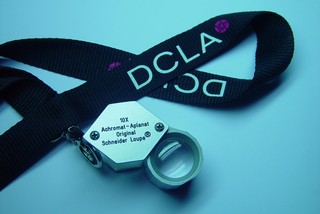A diamond loupe is a small, handheld magnifying lens that is an essential tool for examining diamonds, especially when it comes to evaluating their clarity. It allows gemologists, jewellers, and buyers to inspect the intricate details of a diamond, helping to identify inclusions, blemishes, and other microscopic characteristics that affect its overall quality.
Key Features of a Diamond Loupe
Magnification Power:
The most common magnification used for grading diamonds is 10x magnification. This level of magnification is optimal for examining the intricate details of a diamond without causing strain on the eyes or distorting the image.
While 10x magnification is standard, there are loupes available with higher magnifications (e.g., 20x, 30x) for more detailed inspection. However, 10x is generally the ideal magnification for most grading purposes.
Lens Quality:
A high-quality diamond loupe is typically made with achromatic lenses to reduce colour distortion and correct for chromatic aberrations, ensuring clear and accurate magnification. Loupes must be carefully crafted to ensure that they do not distort the image, especially when examining tiny inclusions or imperfections within the diamond.
The lenses in a good diamond loupe should also be free from spherical aberration, which can cause the image to appear blurry around the edges. This is essential for accurate evaluation.
Optical Clarity:
The lens of the loupe should provide a sharp, crisp image, free of distortions, allowing the user to easily identify the smallest of inclusions and other characteristics. Diamond clarity, which includes the presence of natural inclusions and surface blemishes, is assessed based on the ability to see these minute details under magnification.
Purpose of a Diamond Loupe in Clarity Grading
Clarity Assessment:
When grading the clarity of a diamond, a loupe is used to inspect the stone under 10x magnification to determine the size, location, and nature of any inclusions or blemishes present inside or on the surface of the diamond. The Gemological Institute of America (GIA), for example, uses this tool when assigning clarity grades to diamonds.
Diamonds with fewer or no inclusions are typically given higher clarity grades (such as Flawless or Internally Flawless), while diamonds with more visible inclusions or surface blemishes are graded lower (e.g., SI1, SI2).
Inclusion Identification:
A diamond loupe is indispensable for identifying inclusions such as clouds, crystals, pinpoints, and feathers within the diamond. These inclusions can affect the diamond’s clarity and its overall value. The clarity grade is based on the number, size, location, and visibility of these imperfections, making the loupe an indispensable tool for any professional examining diamonds.
Blemishes on the surface of a diamond, such as scratches, chips, or natural marks, are also easily visible under magnification, helping in the evaluation of the stone’s overall appearance and quality.
Facets Inspection:
While the loupe is primarily used to examine clarity, it is also useful for assessing the quality of the cut. A skilled observer can identify issues with facet alignment, polish, and symmetry that might not be noticeable with the naked eye. The loupe allows professionals to examine whether the facets meet at the correct angles and whether the diamond exhibits good brilliance and scintillation.
Types of Diamond Loupes
Single-Lens Loupe:
The most common and traditional type of loupe, a single-lens loupe typically has a fixed 10x magnification. It is compact and portable, fitting comfortably in a jeweller’s pocket. The single lens makes it simple to use, and it is widely regarded as the standard tool for diamond clarity grading.
Triplet Loupe:
A triplet loupe features three lenses, which are fused together to form a single lens system. This design allows for better correction of optical distortions, particularly spherical and chromatic aberration, providing clearer and more accurate magnification. While often slightly more expensive, triplet loupes are preferred by professionals for their superior clarity.
Binocular Loupe:
A binocular loupe uses two lenses, providing a wider field of view and a more comfortable viewing experience, as it reduces eye strain compared to using a single-lens loupe. While it is not as portable as a single-lens loupe, it offers more detailed and comfortable magnification for longer periods of use.
How to Use a Diamond Loupe
Proper Positioning:
To get the most accurate magnification, position the loupe about 1–2 inches from the surface of the diamond. Hold the loupe up to your eye and move the diamond until it is in focus. The clarity of the diamond will become more apparent as you carefully examine its surface and internal characteristics.
It’s important to hold the diamond steady while examining it to ensure that the details are clearly visible. Some jewellers use diamond holders or trays to secure the stone during examination.
Lighting Conditions:
Lighting plays a critical role in clarity grading. A bright, focused light source, such as a desk lamp with a white light or a gemlight, is often used to illuminate the diamond while using a loupe. Proper lighting helps illuminate inclusions and other features, making them more visible and easier to assess.
Examine the Diamond in Sections:
When inspecting a diamond, it’s important to examine it systematically, looking at all sides and angles. Start by inspecting the table (the flat top surface), and then move to the crown, pavilion, and girdle. Rotate the diamond as you look through the loupe to get a comprehensive view of its clarity.
Maintaining Your Diamond Loupe
Cleaning:
Since a diamond loupe is used to examine the smallest details, it’s crucial to keep the lens clean. Smudges or dirt can obscure the clarity of the diamond, making it difficult to evaluate. Use a microfiber cloth or a lens cleaning solution to gently clean the loupe lens.
Storage:
Store the loupe in a protective case when not in use to prevent scratches or damage to the lens. A well-maintained loupe will provide accurate and reliable results for many years.
